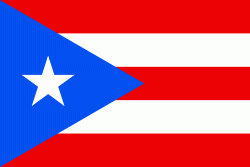Trujillo Alto (Trujillo Alto Municipio)
 |
Trujillo Alto was officially founded in 1801, but gained more importance during the 20th century. Due to its proximity to the capital, San Juan, the city has become a suburb of the metropolitan area, which has sparked its growth during recent years. The population of Trujillo Alto has increased through the last century from 9,576 (1930) to 74,482 (2010). According to the 2010 Census, it is Puerto Rico's tenth-most populated municipality.
In 1953–54, the Carraízo hydroelectric dam was constructed in Trujillo Alto by the Sumner Sollitt Construction Company of Chicago, under contract by the Puerto Rico Water Resources Authority. The dam forms the Loíza Lake, a reservoir which serves as the main source of the water supply for San Juan, Puerto Rico.
The region of what is now Trujillo Alto belonged to the Taíno region of Cayniabón, which stretched from the northeast coast of Puerto Rico into the central region of the island. The region was led by cacique Canobaná. Archeological findings have identified two sites within the municipality of Trujillo Alto with archeological significance: Las Cuevas, which was studied by Irving Rouse, and Quebrada Grande.
After the Spanish colonization, families started settling at both sides of the Río Grande de Loíza. During the 17th century, the Spanish crown granted Alonso Pizarro Hermona, from Trujillo in Spain, a vast ranch that covered the region. Residents began using his family name to refer to the location. Eventually, the inhabitants went to the Governor and asked for permit to build a chapel, which was a requisite to officially found a town. Despite some opposition, Trujillo Alto was founded on January 8, 1801, under the name of Santa Cruz de Trujillo. The town was settled on a meander of the Grande de Loiza River. Around 1820, the name Trujillo Alto was more used to differentiate the town from that of Trujillo Bajo (which later became known as Carolina). In 1826, communication to and from the town improved with the construction of two bridges: one into Río Piedras, and the other into Río Grande. In 1844, Trujillo Alto was composed of only five barrios. A few years later, the first school was built. During that time, population decreased notably due to an epidemic of cholera.
Puerto Rico was ceded by Spain in the aftermath of the Spanish–American War under the terms of the Treaty of Paris of 1898 and became a territory of the United States. In 1899, the United States conducted its first census of Puerto Rico finding that the population of Trujillo Alto was 5,683.
In 1902, the Legislative Assembly of Puerto Rico approved a law for the consolidation of certain municipalities. As a result, Trujillo Alto was incorporated into the town of Carolina. However, in 1905 a new law revoked the previous one, turning Trujillo Alto into an independent municipality again.
The proximity of the city to the capital, San Juan, has sparked significant growth and development in the region. During the 20th century, the population of Trujillo Alto increased dramatically. As of 2010, the city is the tenth-most populous city of Puerto Rico. Mayor José Luis Cruz Cruz, who has been serving since 2009, has labeled the city as "The New Metropolis".
Hurricane Maria on September 20, 2017, triggered numerous landslides in Trujillo Alto, due to the significant amount of rainfall. The hurricane winds and rain damaged infrastructure and caused almost the entire electrical system of Trujillo Alto to collapse leaving its nearly 75,000 residents with no electrical power, and 90% of the residents lost access to clean, drinking water.
Map - Trujillo Alto (Trujillo Alto Municipio)
Map
Country - Puerto Rico
 |
 |
Currency / Language
| ISO | Currency | Symbol | Significant figures |
|---|---|---|---|
| USD | United States dollar | $ | 2 |
| ISO | Language |
|---|---|
| EN | English language |
| ES | Spanish language |















